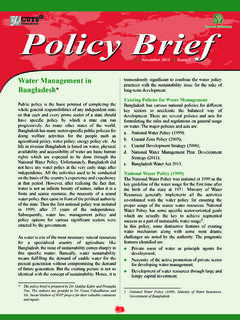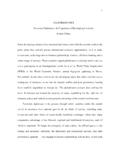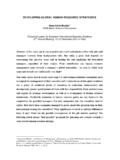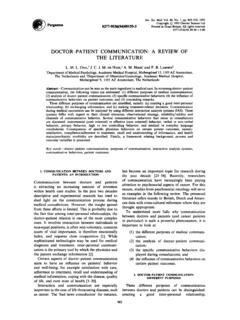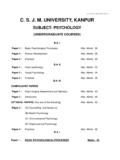Transcription of Communication: An Essential Aspect of Diplomacy
1 communication : An Essential Aspect of Diplomacy Christer J nsson & Martin Hall Department of Political Science, Lund University [Prepared for 43rd Annual ISA Convention, New Orleans, LA, March 23-27, 2002; panel WA23: Diplomatic Theory and Practice] communication is to Diplomacy as blood is to the human body. Whenever communication ceases, the body of international politics, the process of Diplomacy , is dead, and the result is violent conflict or atrophy. (Tran, 1987: 8) Observers and practitioners alike testify to the vital role of communication in Diplomacy .
2 In fact, Diplomacy is often defined in terms of communication as a regulated process of communication (Constantinou, 1996: 25) or the communi-cation system of the international society (James, 1980: 942), to mention but two examples. Symbolic representations of Diplomacy as well tend to highlight its communicative aspects . For instance, the illustrations in Byzantine manuscripts of a scroll handed from a bowing envoy to a seated figure are a clear shorthand for an embassy (Mullet, 1992: 204).
3 The association of Diplomacy with communication goes far back in history. It is sometimes argued that the first diplomats were angels, messengers between deities and human beings (see, , Nicolson, 1963: 5-6). Even if this notion may be dismissed as mytho- Diplomacy (Der Derian, 1987b: 44-67), we should remember, in two classical languages, Hebrew and Greek, the words for messenger ( mal ach in Hebrew and angelos in Greek) convey the idea of sacredness as well as of secular mission (Eban, 1983: 333; cf.)
4 Der Derian, 1987b: 65). In Ancient Greece Hermes, the divine messenger, was the deity of language and Diplomacy , and the most prominent diplomatic emissaries, heralds (kerykes), were regarded as the offspring of Hermes. The sanctity of diplomatic messengers in the ancient world implied inviolability and thus foreshadowed more recent notions of diplomatic immunity (Frey & Frey, 1999: 11; Eban, 1983: 333). communication also looms large in critical reflections upon contemporary and future Diplomacy , as epitomized in such labels as techno- Diplomacy (Der Derian, 1987b: 199-209), media Diplomacy (Rawnsley, 1999; Cohen, 1986) and digital Diplomacy (Dizard, 2001).
5 Thus, this paper will focus on transhistorical or timeless aspects of diplomatic communication . It forms part of a research project, in which we pursue three Essential aspects of Diplomacy : representation, communication and the reproduction of international society We proceed from the notion that Diplomacy expresses a human condition that precedes and transcends the experience of living in the sovereign, territorial states of the past few hundred years (Sharp, 1999: 51). Diplomacy , in short, exists whenever there are boundaries for identity and those boundaries of identity are crossed (Constantinou, 1996: 113).
6 Thus, a first step in our research strategy has been to abandon the state-centric perspective that has dominated the study of Diplomacy . Instead we conceive of Diplomacy as an institution structuring relations among polities. A polity can be understood as a political authority, which has a distinct identity; a capacity to mobilize persons and their resources for political purposes, that is, for value satisfaction; and a degree of institutionalisation and hierarchy (leaders and constituents) (Ferguson and Mansbach, 1996: 34).
7 The modest purpose of this paper is to outline a number of pertinent dimensions of the communicative aspects of Diplomacy and to proffer examples taken from different eras and geographic regions. More specifically, we will discuss continuity and change in the following dimensions: verbal / nonverbal communication , information gathering, diplomatic signaling, interaction capacity, and ritualisation. Our paper is exploratory in nature; it might be seen as a first step toward theory building in a field that has not been the object of much theorizing (Der Derian, 1987a: 91).
8 If Diplomacy is as old as social history (Eban, 1983: 332) or perhaps much older than even recorded history (Mookerjee, 1973: 4), what are its enduring features and variable traits? That is the overarching question guiding our project in general, and this paper on communication in particular. Verbal and nonverbal communication Social communication , including diplomatic communication , involves the transmission of messages to which certain meanings are attached. These messages can be either verbal or nonverbal.
9 Just as the verbal components in a normal person-to-person conversation have been estimated to carry little more than a third of the social meaning (Johnson, 1974: 74), so nonverbal messages or body language constitute important aspects of diplomatic communication . Diplomatic body language encompasses everything from personal gestures to the manipulation of military forces. A handshake, for example, is commonly used as a metaphor for the quality of inter-state relations, transferring the language of personal relations to the international arena.
10 The venue and format of meetings as well as the shape of the negotiating table (symbolizing prestige and power) and the level of delegations (signaling interests and intentions of the parties) are other aspects that can be used for subtle body language (cf. Cohen, 1981: 39-40). Nonverbal communication has certain advantages. It is often better able to capture the attention and interest of various audiences than is verbal communication . If nonverbal communication did not exist, argues Raymond Cohen (1987: 24), it would have been invented by public relations officers.
